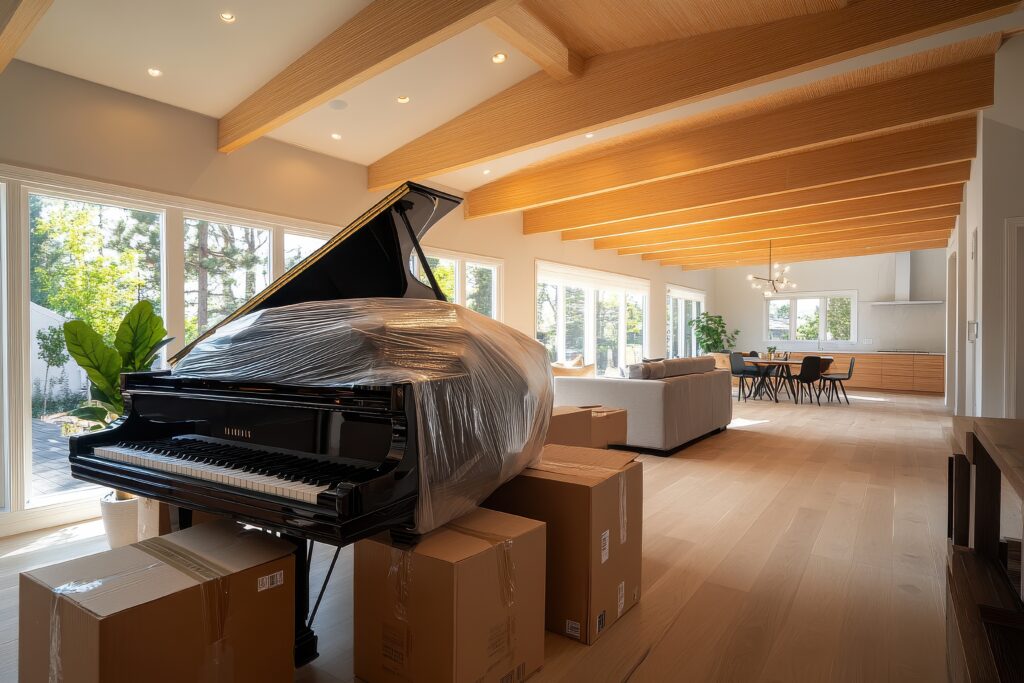
Moving a piano is not as simple as shifting a piece of furniture. Due to their weight, size, and delicate internal components, pianos require expert handling to prevent costly damage. Improper moving techniques can lead to structural cracks, tuning instability, and even personal injury. Whether relocating across town or to a new home, hiring experienced piano movers Colorado Springs ensures a safe and damage-free process. Understanding the risks of poor handling can help piano owners make an informed decision about professional moving services. Here’s what can happen if a piano isn’t moved correctly.
Structural Damage – How Mishandling Can Crack Wood or Misalign Parts
1. Cracks and Breaks in the Frame
Pianos are primarily made of wood, which can crack under excessive pressure or sudden impacts. Dropping a piano, improper lifting, or rough handling can cause visible fractures in the outer casing, legs, or even the internal soundboard. Repairing these damages can be expensive and may permanently impact the instrument’s quality.
2. Misalignment of Internal Components
A piano’s internal parts must remain precisely positioned for it to function correctly. Mishandling during a move can shift or dislodge vital components like the action assembly, pedals, or even the cast-iron frame. Even slight misalignments can affect playability, requiring professional adjustments or repairs.
3. Weakening of Glue Joints
Pianos are held together with strong adhesive joints that keep the structure intact. Exposure to vibrations, sudden temperature changes, or improper lifting techniques can weaken these joints, causing separation over time. This can lead to wobbly legs, unstable casings, or a general loss of structural integrity.
Tuning Issues – How Poor Handling Affects Sound Quality
1. String Tension Disruptions
A piano’s tuning depends on consistent string tension. Sudden jostling or improper positioning during a move can alter this tension, leading to notes sounding flat or sharp. This issue often requires professional retuning, which can be costly and time-consuming.
2. Harmonic Imbalance
Even if the strings remain intact, rough handling can disturb the delicate balance of the piano’s harmonics. Notes may sound uneven, keys may produce inconsistent tones, or the overall sound may feel muted or harsh. Professional tuners may need to make multiple adjustments to restore sound quality.
3. Environmental Impact on Tuning Stability
Pianos are highly sensitive to environmental changes. Moving a piano improperly—especially in a non-climate-controlled truck—can expose it to temperature and humidity fluctuations. Wood expands and contracts under these conditions, causing tuning instability and long-term tonal inconsistencies.
Key & String Damage – Why Sudden Impacts Can Ruin Internal Components
1. Key Misalignment and Sticking
Pianos have hundreds of keys and hammers, all delicately aligned for smooth playability. If a piano is tilted at the wrong angle or subjected to an impact, keys can shift out of place, causing them to stick, become unresponsive, or produce uneven sounds. Learn more about how the professionals handle your piano moving safely, read “How Piano Movers Protect Your Instrument During Transit.”
2. String Breakage
The strings inside a piano are under extreme tension. A sudden impact, improper angling, or excessive vibration during transportation can snap or loosen strings. Replacing broken strings and rebalancing the instrument requires professional intervention, adding unexpected costs.
3. Hammer and Damper Malfunctions
Each key press activates a hammer that strikes a string, producing sound. If the piano is moved improperly, these hammers may become misaligned or damaged. Similarly, dampers—responsible for controlling sustain—may malfunction, leading to irregular sound behavior.
Floor & Property Damage – How Heavy Pianos Can Cause Scratches and Dents
1. Scratches and Gouges in the Flooring
Pianos are extremely heavy, with some models exceeding 1,000 pounds. If dragged or improperly lifted, they can leave deep scratches, dents, or gouges on hardwood, tile, or laminate floors. Even carpeted surfaces can suffer from excessive pressure, causing uneven wear and damage.
2. Wall and Doorway Damage
Navigating a piano through tight spaces is difficult without professional expertise. If movers miscalculate angles, the piano can scrape against walls, chip door frames, or even crack drywall. These damages not only require costly repairs but can also decrease a home’s aesthetic appeal.
3. Furniture and Object Damage
Without proper maneuvering, a piano can bump into nearby furniture, knocking over lamps, shelves, or fragile décor. In confined spaces, the risk of damaging other belongings increases, making professional moving services a safer option.
Injury Risks – Dangers of Improper Lifting Techniques
1. Back and Muscle Strain
Moving a piano without professional training puts immense strain on the back, arms, and legs. Without the correct lifting technique, movers risk serious muscle injuries, including pulled ligaments, spinal stress, and chronic pain. Even with multiple people assisting, improper posture and coordination can lead to physical strain.
2. Finger and Hand Injuries
Given the weight and size of a piano, fingers, and hands can easily become pinched or crushed during lifting and repositioning. Mishandling the instrument or failing to secure a proper grip can result in severe bruising or even fractures.
3. Tripping and Falling Hazards
Pianos must be moved with precision to prevent accidental trips or falls. If a mover loses balance or stumbles while carrying a piano, the consequences can be severe—not just for the movers, but also for the instrument and surrounding property. Professional movers use specialized equipment to prevent such accidents.
Conclusion
Moving a piano improperly can lead to a host of problems, from structural damage and tuning issues to personal injury and property destruction. Without the right expertise and equipment, handling a piano can be risky and expensive. Professional piano movers have the training, tools, and experience needed to transport pianos safely. Whether moving across the street or across the state, hiring experts ensures a smooth process while preserving the instrument’s integrity. Protecting a piano requires careful planning, and professional movers provide the safest solution.
Pianos are more than just instruments—they are cherished investments that deserve expert care. Mountain Piano Moving Company ensures safe and professional handling, whether for a local move or a long-distance relocation. Don’t risk costly damage or injury by attempting to move a piano without the right equipment. Let experienced movers handle the hard work while keeping your instrument in perfect condition. Contact our team today for a quote and let the professionals deal with your piano.

